It looks like you're using an Ad Blocker.
Please white-list or disable AboveTopSecret.com in your ad-blocking tool.
Thank you.
Some features of ATS will be disabled while you continue to use an ad-blocker.
10
share:
I was once initiated into a Wiccan Coven, a very old tradition in Celtic Cornwall. It was many years ago. I did renounce this after a mind blowing
experience quite literally involving Christ. However, in the interests of the past, as I still do respect other religions, I take an interest and keep
studying as it all fascinates me regarding human evolution in the realms of spiritual development.
I got a strange illuminating experience relating to Vodou recently. It is a fascinating religion, a hybrid of the African Loas and the Catholic Saints. My own argument is that Vodou was a clever way the enslaved Africans could disguise their traditional worship in Christianity. Not only that, the Saints had respect, too, and it became a mixture of the Old West African Tradition and Catholic Christianity. Think "Christmas", "Easter", etc and we, too, have had our experiences of Pagan expressions being remembered and replaced by the Christian festivals, so much so that the Christian part apart from Easter is mainly myth where the Pagan celebration expression was the actual and real deal. I am sure any learned Vodou initiate would respect the actual personage of Christ as they do the Saints. Most learned Wiccans I have met respect Christ, too. That is because religion and its expression in all forms is respected by them. As a Christian I feel the same way about the Pagan religions.
I have noticed how closely the Vodou "Crossroads" resembles the magic and sacred circle of Wicca. These are places one can access where our world meets the spirit world; a dimensional gateway. Even the Hebrew Judaism has Merkabah, which is in essence very similar indeed.
How strange that these gateways should appear in African Paganism, Wiccan fragments of the old Paganism of Britain (yes, those Gardnerian rituals really do preserve a very old remembrance of the Gateway). Even in Christianity we have St.Peter who is the "Gatekeeper" of Heaven and is depicted holding keys as does Papa Legba in Vodou. Papa Legba is even depicted holding keys:
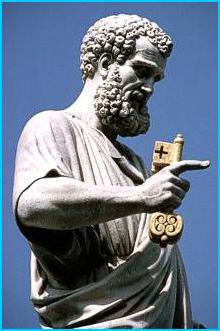
St Peter with the key to the Kingdom.
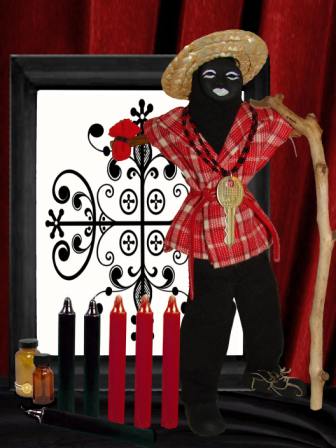
Papa Legba with the key to Guinee
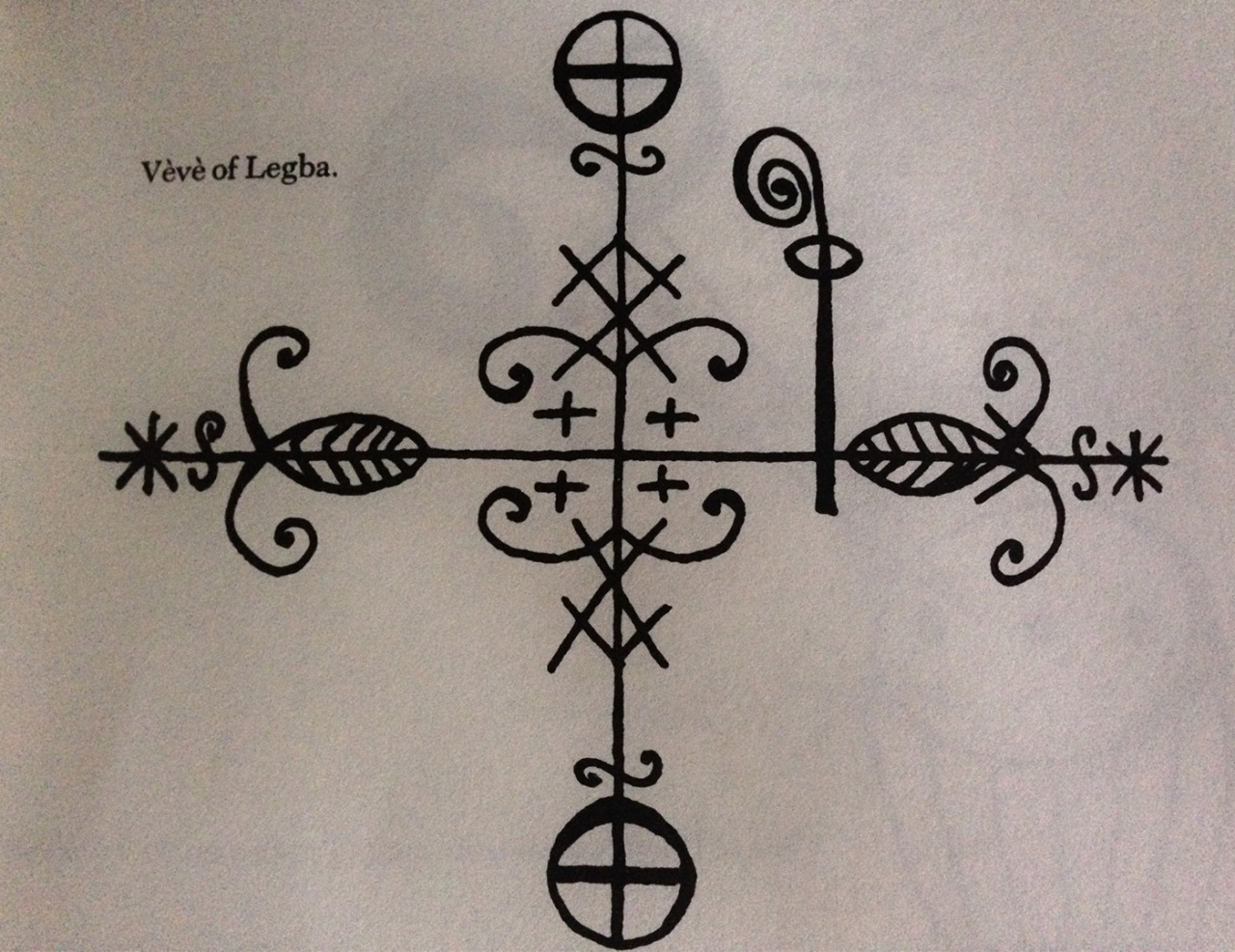
"Vèvè of Papa Legba - Master of the Crossroads, Guardian of the Pathways of Entrance"
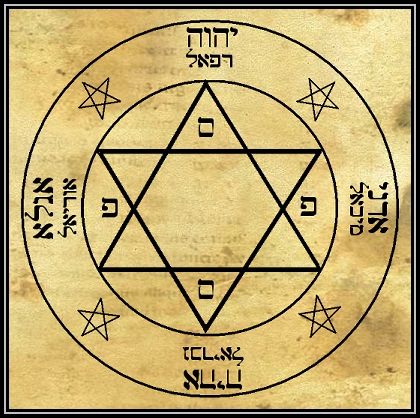
Solomonic Occult Magic Circle (Merkabah is the exact same spirit vehicle as the Wiccan Magic Circle, just different in incantation perhaps?)
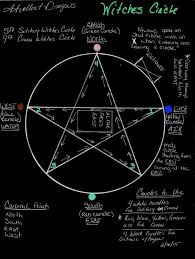
Wiccan Magic Circle
In Wicca when the circle is cast the Guardians of the "Four Directions" are summoned to witness the ritual and guard the circle. At the close of the circle they must also be bidden farewell and told to depart. This is the Wicca version of the "Crossroads":
wiccalessons.wordpress.com...
"The traditional Wiccan way of calling the elements, which is published in many books on Wicca is as follows:
"Ye Lords of the Watchtowers of the East, ye Lords of Air; I do summon call and stir you up, to witness our rites and to guard the Circle
Ye Lords of the Watchtowers of the South, ye Lords of Fire; I do summon call and stir you up, to witness our rites and to guard the Circle
Ye Lords of the Watchtowers of the West, ye Lords of Water; I do summon call and stir you up, to witness our rites and to guard the Circle
Ye Lords of the Watchtowers of the North, ye Lords of Earth; I do summon call and stir you up, to witness our rites and to guard the Circle"".
The Spiritual Crossroads is a spiritual theme of Pagan Africa, Wiccan preservation of ancient fragments of Pagan Britain and there is an occult equivalent in Cabala Judaism. Even Christ said to Peter,
Matthew 16:19;
Peter and Papa Legba have very similar roles indeed.
So, to to end my thread after I wrote all that I could have said something simple like "Isn't it interesting how there is a folk legend and indeed still a Wiccan belief about the "Crossroads" being a venue for rituals, the Blues recording in song the folk legend of the "Crossroads" as well as the Vodou "Crorssroads".
Put that together with information like this:
books.google.co.uk... PxRi4c0XPXDSNVnZYVCLzeRk&hl=en&sa=X&ved=0ahUKEwjg9vTh6f_XAhVBK8AKHXJJAfgQ6AEIVjAJ#v=onepage&q=Did%20Macbeths%20witches%20meet%20at%20the%20crossroads& f=false
(Sorry, will not let me screenshot and don't have any other software)
We can now see that even as far back as Hecate the Goddess religions held the "Crossroads" as sacred. It is symbolically "the centre of town", the centre of the community;
Macbeth's Three Witches are a symbol of the triple Goddess and he meets them at the "Crossroads". Patriarchal belief systems obviously demonized all this as it took over, yet we still have so many clues and echoes; even pockets of practice and a resurgent interest. It i common knowledge that Hecate is the goddess of the Witches, from L.A to the British countryside!
It brings a whole new meaning to Robert Johnson's Blues Song. Not so much devil worship, but an echo of a universal gateway that seems to reverberate through many of our belief systems and haunts our culture even in music.
It is this song that sparked me off on my current studies. See how important music can be as a tool to unlocking our collective experience, past and present, what comes from what. It is like unraveling knots in a string.
Where Blues and Robert Johnson meet Macbeth.
I got a strange illuminating experience relating to Vodou recently. It is a fascinating religion, a hybrid of the African Loas and the Catholic Saints. My own argument is that Vodou was a clever way the enslaved Africans could disguise their traditional worship in Christianity. Not only that, the Saints had respect, too, and it became a mixture of the Old West African Tradition and Catholic Christianity. Think "Christmas", "Easter", etc and we, too, have had our experiences of Pagan expressions being remembered and replaced by the Christian festivals, so much so that the Christian part apart from Easter is mainly myth where the Pagan celebration expression was the actual and real deal. I am sure any learned Vodou initiate would respect the actual personage of Christ as they do the Saints. Most learned Wiccans I have met respect Christ, too. That is because religion and its expression in all forms is respected by them. As a Christian I feel the same way about the Pagan religions.
I have noticed how closely the Vodou "Crossroads" resembles the magic and sacred circle of Wicca. These are places one can access where our world meets the spirit world; a dimensional gateway. Even the Hebrew Judaism has Merkabah, which is in essence very similar indeed.
How strange that these gateways should appear in African Paganism, Wiccan fragments of the old Paganism of Britain (yes, those Gardnerian rituals really do preserve a very old remembrance of the Gateway). Even in Christianity we have St.Peter who is the "Gatekeeper" of Heaven and is depicted holding keys as does Papa Legba in Vodou. Papa Legba is even depicted holding keys:

St Peter with the key to the Kingdom.

Papa Legba with the key to Guinee

"Vèvè of Papa Legba - Master of the Crossroads, Guardian of the Pathways of Entrance"

Solomonic Occult Magic Circle (Merkabah is the exact same spirit vehicle as the Wiccan Magic Circle, just different in incantation perhaps?)

Wiccan Magic Circle
In Wicca when the circle is cast the Guardians of the "Four Directions" are summoned to witness the ritual and guard the circle. At the close of the circle they must also be bidden farewell and told to depart. This is the Wicca version of the "Crossroads":
wiccalessons.wordpress.com...
"The traditional Wiccan way of calling the elements, which is published in many books on Wicca is as follows:
"Ye Lords of the Watchtowers of the East, ye Lords of Air; I do summon call and stir you up, to witness our rites and to guard the Circle
Ye Lords of the Watchtowers of the South, ye Lords of Fire; I do summon call and stir you up, to witness our rites and to guard the Circle
Ye Lords of the Watchtowers of the West, ye Lords of Water; I do summon call and stir you up, to witness our rites and to guard the Circle
Ye Lords of the Watchtowers of the North, ye Lords of Earth; I do summon call and stir you up, to witness our rites and to guard the Circle"".
The Spiritual Crossroads is a spiritual theme of Pagan Africa, Wiccan preservation of ancient fragments of Pagan Britain and there is an occult equivalent in Cabala Judaism. Even Christ said to Peter,
Matthew 16:19;
New International Version I will give you the keys of the kingdom of heaven; whatever you bind on earth will be bound in heaven, and whatever you loose on earth will be loosed in heaven."
Peter and Papa Legba have very similar roles indeed.
So, to to end my thread after I wrote all that I could have said something simple like "Isn't it interesting how there is a folk legend and indeed still a Wiccan belief about the "Crossroads" being a venue for rituals, the Blues recording in song the folk legend of the "Crossroads" as well as the Vodou "Crorssroads".
Put that together with information like this:
books.google.co.uk... PxRi4c0XPXDSNVnZYVCLzeRk&hl=en&sa=X&ved=0ahUKEwjg9vTh6f_XAhVBK8AKHXJJAfgQ6AEIVjAJ#v=onepage&q=Did%20Macbeths%20witches%20meet%20at%20the%20crossroads& f=false
(Sorry, will not let me screenshot and don't have any other software)
We can now see that even as far back as Hecate the Goddess religions held the "Crossroads" as sacred. It is symbolically "the centre of town", the centre of the community;
the fertile centre of the community
Macbeth's Three Witches are a symbol of the triple Goddess and he meets them at the "Crossroads". Patriarchal belief systems obviously demonized all this as it took over, yet we still have so many clues and echoes; even pockets of practice and a resurgent interest. It i common knowledge that Hecate is the goddess of the Witches, from L.A to the British countryside!
It brings a whole new meaning to Robert Johnson's Blues Song. Not so much devil worship, but an echo of a universal gateway that seems to reverberate through many of our belief systems and haunts our culture even in music.
It is this song that sparked me off on my current studies. See how important music can be as a tool to unlocking our collective experience, past and present, what comes from what. It is like unraveling knots in a string.
Where Blues and Robert Johnson meet Macbeth.
edit on 10-12-2017 by Revolution9 because: (no reason given)
Studying of Symbology is for the symbol minded.
How many geometric shapes are there in Geometry anyway?
So math must be a religion, right?
How many geometric shapes are there in Geometry anyway?
So math must be a religion, right?
a reply to: Revolution9
That is because western Wicca was partially created from voodoo.
(As a disclaimer , it’s been awhile once I looked into it, so I might get some oth is a hair wrong, but the theme should be correct.)
You can trace all of western spiritualism back to like the 1960s..
You gotta think they burned/executes/jailed heritics in the West before like 200 years ago..
AND THAT WAS WHAT THEY DID TO CHRISTIAN HERETICS WHO BELIEVED IN CHRIST, but disagreed with teachings..
People they could flat out label witches and devil worshiper ms would have gotten worse..
So there is no unbroken line from the ancient celts to now..
There is no Ancient Wiccan texts that has survived the centuries.
Wicca/spiritualism and all the crystal magic toe stuff was rediscovered and popularized in the early and mid 1900s.
Long after voodoo.
In fact I think most of it all goes back to one book that became popular and started it all.
It is not strange they share the same symbolism, because those who crafted modern day Wicca leafed through the preexisting religions and incorporated what they wanted and left the rest.
That is because western Wicca was partially created from voodoo.
(As a disclaimer , it’s been awhile once I looked into it, so I might get some oth is a hair wrong, but the theme should be correct.)
You can trace all of western spiritualism back to like the 1960s..
You gotta think they burned/executes/jailed heritics in the West before like 200 years ago..
AND THAT WAS WHAT THEY DID TO CHRISTIAN HERETICS WHO BELIEVED IN CHRIST, but disagreed with teachings..
People they could flat out label witches and devil worshiper ms would have gotten worse..
So there is no unbroken line from the ancient celts to now..
There is no Ancient Wiccan texts that has survived the centuries.
Wicca/spiritualism and all the crystal magic toe stuff was rediscovered and popularized in the early and mid 1900s.
Long after voodoo.
In fact I think most of it all goes back to one book that became popular and started it all.
It is not strange they share the same symbolism, because those who crafted modern day Wicca leafed through the preexisting religions and incorporated what they wanted and left the rest.
a reply to: Revolution9
Fro the Wicca wiki page.
“Wicca (English: /ˈwɪkə/), also termed Pagan Witchcraft, is a contemporary Pagan new religious movement. It was developed in England during the first half of the 20th century and was introduced to the public in 1954 by Gerald Gardner, a retired British civil servant. Wicca draws upon a diverse set of ancient pagan and 20th-century hermetic motifs for its theological structure and ritual practices.”
When it was invented in the 1950s all the symbolism you mentioned was already available to be appropriated.
Fro the Wicca wiki page.
“Wicca (English: /ˈwɪkə/), also termed Pagan Witchcraft, is a contemporary Pagan new religious movement. It was developed in England during the first half of the 20th century and was introduced to the public in 1954 by Gerald Gardner, a retired British civil servant. Wicca draws upon a diverse set of ancient pagan and 20th-century hermetic motifs for its theological structure and ritual practices.”
When it was invented in the 1950s all the symbolism you mentioned was already available to be appropriated.
Stop being so silly. Look at what I wrote proerly. It is obvious. You ar just being an Eeyore and YOU KNOW IT!
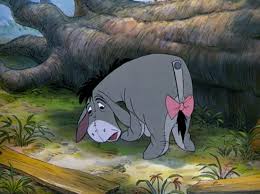

edit on 10-12-2017 by Revolution9 because: (no reason given)
a reply to: intrptr
More than that, what kinda SECRET society ADVERTISES THEIR EXISTENCE?!!!
One who doesn’t plan on staying a secret for very long lol!
Can you imagaine the board meeting where someone proposed,
A) even creating symbols that could be applied to your super secret group and help identify you if your ever outted..
B) “hey guys, I know we are trying to fly below the radar and everything, but what do y’all think about recruiting all the worlds best movie directors and architects, so we can hide our newly created symbols in movies and such?? “
Isn’t that like the oxymoron of a super secret group trying to remain a secret?!?!
Lol
More than that, what kinda SECRET society ADVERTISES THEIR EXISTENCE?!!!
One who doesn’t plan on staying a secret for very long lol!
Can you imagaine the board meeting where someone proposed,
A) even creating symbols that could be applied to your super secret group and help identify you if your ever outted..
B) “hey guys, I know we are trying to fly below the radar and everything, but what do y’all think about recruiting all the worlds best movie directors and architects, so we can hide our newly created symbols in movies and such?? “
Isn’t that like the oxymoron of a super secret group trying to remain a secret?!?!
Lol
originally posted by: JoshuaCox
a reply to: Revolution9
Fro the Wicca wiki page.
“Wicca (English: /ˈwɪkə/), also termed Pagan Witchcraft, is a contemporary Pagan new religious movement. It was developed in England during the first half of the 20th century and was introduced to the public in 1954 by Gerald Gardner, a retired British civil servant. Wicca draws upon a diverse set of ancient pagan and 20th-century hermetic motifs for its theological structure and ritual practices.”
When it was invented in the 1950s all the symbolism you mentioned was already available to be appropriated.
It was invented a lot earlier than that. It is traceable here in Cornwall and Gardner himself was earlier than 1950s. I know, believe me.
Why do you not comment on what I have written? It is obvious to me and anyone with their eyes open that these echoes trace back a long long time. Certainly in Africa they do. Look at what I wrote properly. The British and European folk practices were demonized as we know and people could be burned in the fire for being reported for doing anything that related to magic and the pagan worship. There was a PURGE in Europe and the U.S. It was not just superstition, but a very real handed down belief system in the rural communities. It was deliberately, mercilessly and ruthlessly purged and cleansed away. The Inquisitors and the authorities knew exactly what they were doing. Yes, elements have survived in Vodou, Wicca and other occult systems. My friend here in Cornwall has written many books about Folk Magic. Yes, these people kept it alive and many of them were very persecuted and alienated for it, even after the Witch Hunts and Burnings.
www.amazon.co.uk...
She is the real deal. She and her academic friend have thoroughly researched Witchcraft history here in the West Country. It is REAL!People really do it. I have done it. I know a fair few people who are doing it. There are many echoes in the modern practices remembered from the past before the purge. African people were banned from it and were whipped if they practiced it. They hid it in times of persecution, so did Masons and so did the Pagan wise folk.
edit on 10-12-2017 by Revolution9 because: (no reason given)
Gerald Gardner did not "invent" this. The "'Obby Horse" has been going on for thousands of years in Britain, on and off.
This is my town: Look!
Is that evidence of reality enough!
(This video just to show that Pagan belief is unbroken and still remembered in little pockets still).
www.themystica.com...
www.luckymojo.com...
See, other people know it, too, as I am discovering. I am learning. Why don't you learn, too?
Is that evidence of reality enough!
(This video just to show that Pagan belief is unbroken and still remembered in little pockets still).
www.themystica.com...
Crossroad is a symbolic term denoting the union and joining of paths. The association of the crossroad with Witchcraft goes back to ancient Greek and Roman times. Classically the crossroad symbolizes a joining of three roads, the balance of opposites, and the meeting of time and space.
www.luckymojo.com...
The crossroads -- a place where two roads cross at or about at right angles, otherwise known as "the forks of the road" -- is the subject of religious and folkloric belief all around the world. Because the crossroads is land that belongs to no one, a place outside the borders of town, it is considered a suitable site to perform magical rituals and cast spells. The use of the crossroads as an impromptu altar where offerings are placed and rituals performed is widely encountered in both European and African folklore. In ancient Greece, marker stones commemorating the god Hermes in his priapic form were set at the crossroads. In ancient Rome the similar god Mercury was the crossroads guardian. In India, the god Bhairava, an older version of great god Siva, is said to guard the crossroads at the outskirts of villages. Stone phalluses and statues of Bhairava's watchful eyes are erected to represent him as a guardian of the boundaries. In Guatemala, the old Mayan underworld Lord Maam, under his Catholic Saint guise of Maximon or Saint Simon, is generally depicted seated at a crossroads in a chair, just outside a church. In Africa, almost every cultural group has its own version of the crossroads god. Legba, Ellegua, Elegbara, Eshu, Exu, Nbumba Nzila, and Pomba Gira are African and African-diaspora names (in several languages) for the spirit who opens the way, guards the crossroads, and teaches wisdom.
See, other people know it, too, as I am discovering. I am learning. Why don't you learn, too?
edit on 10-12-2017 by Revolution9 because: (no reason given)
a reply to: Revolution9
Wicca dates from the 1950s.... Can't be that old oh and yes I am a pagan, have been for 30 plus years. What lineage was this Wicca if yours?
Wicca dates from the 1950s.... Can't be that old oh and yes I am a pagan, have been for 30 plus years. What lineage was this Wicca if yours?
a reply to: Revolution9
There may well indeed be some connection
www.abovetopsecret.com...
Moors Magic And Witches, a thread I made some yrs back. Based roughly off Arkon Darul's book A History of Secret Sociaties.
The goat frequently showed up in some form of WICCA religions maybe a throw back to the goat of Mendes or Benebdjet connected to the similar sounding Bahomptmet, the goat headed figure found in the west, transformed into a symbol of the devil by Christians.

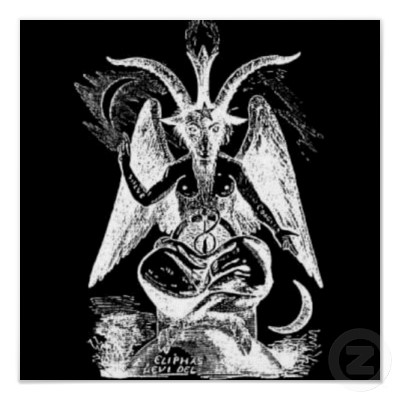
These figures represents fertility rites, some times in the form of Bes the Great lakes god, also worshipped in Egypt and Kush, but adopted in the north Med as Pan.
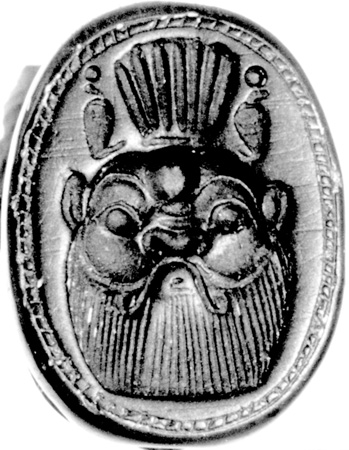
Bes in the south Med.
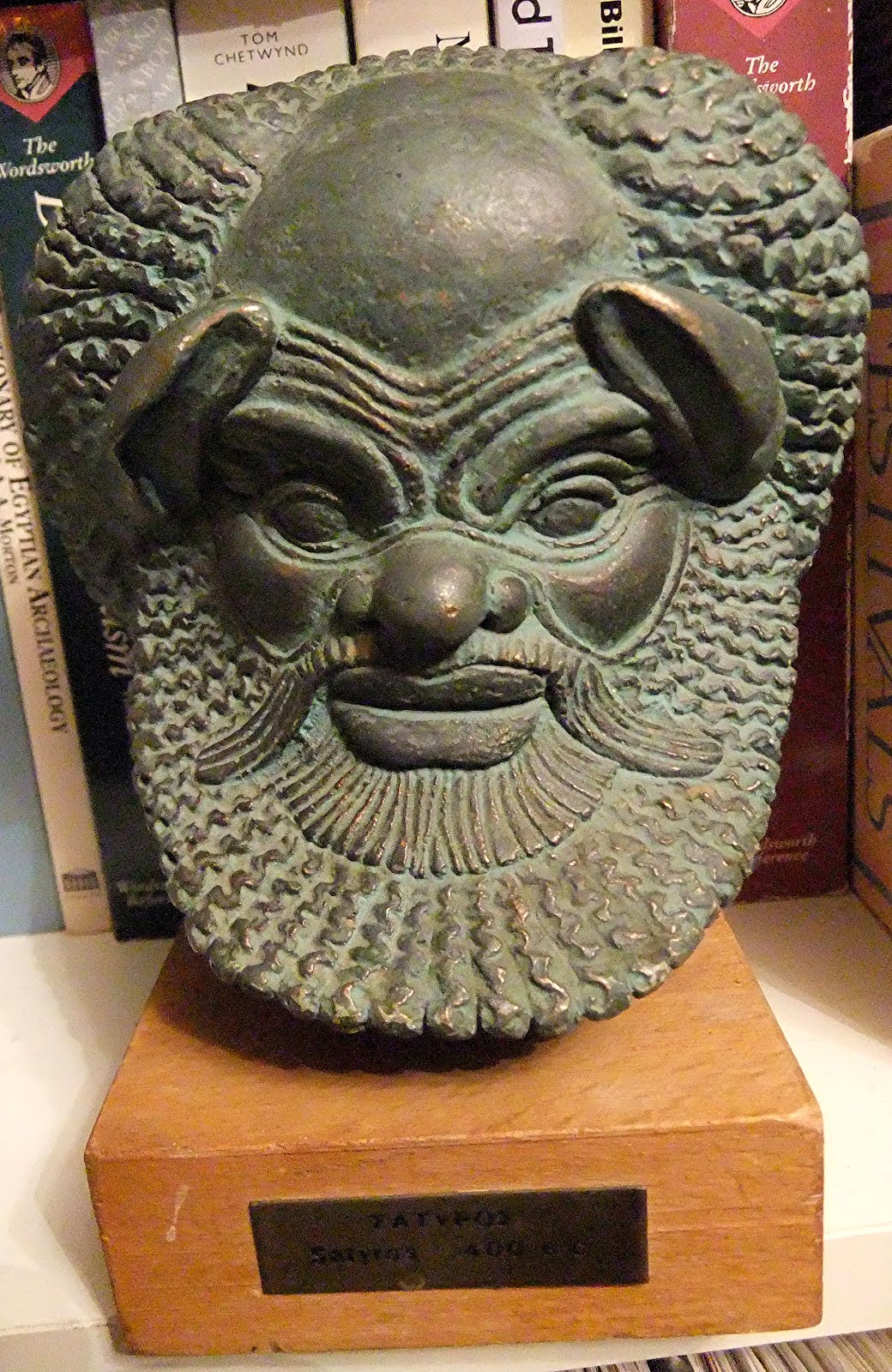
Became Pan in the north Med.
Off course it went though many different filters and bind with other native traditions in Europe.
There may well indeed be some connection
www.abovetopsecret.com...
Moors Magic And Witches, a thread I made some yrs back. Based roughly off Arkon Darul's book A History of Secret Sociaties.
The goat frequently showed up in some form of WICCA religions maybe a throw back to the goat of Mendes or Benebdjet connected to the similar sounding Bahomptmet, the goat headed figure found in the west, transformed into a symbol of the devil by Christians.


These figures represents fertility rites, some times in the form of Bes the Great lakes god, also worshipped in Egypt and Kush, but adopted in the north Med as Pan.

Bes in the south Med.

Became Pan in the north Med.
Off course it went though many different filters and bind with other native traditions in Europe.
edit on 11-12-2017 by Spider879 because: (no
reason given)
Disinfo is rampant here! Nice Eyore tantrum too!
In all seriousness. Wicca. Is. Not. Old.
Claiming unbroken lines is what religions and cults do, it's SOP. Food for suckers.
And whoever thinks modern spiritualism/ality goes back to the 1960s needs to hit the books on the victorian era up to the 1920's.
This is the most basic of stuff.
In all seriousness. Wicca. Is. Not. Old.
Claiming unbroken lines is what religions and cults do, it's SOP. Food for suckers.
And whoever thinks modern spiritualism/ality goes back to the 1960s needs to hit the books on the victorian era up to the 1920's.
This is the most basic of stuff.
edit on 11-12-2017 by skalla because: (no reason given)
edit on 11-12-2017 by skalla because:
(no reason given)
Very interesting read with very interesting correlations. I didn't see this post early, but I'm glad I did.
edit on 20171212 by
ChildOfLoki because: Addendum
a reply to: Revolution9
Good research
Reminds me of this!!!
Some songs have a way of igniting the fire within…
S+F
- JC
Originally posted by Revolution9
Crossroad is a symbolic term denoting the union and joining of paths. The association of the crossroad with Witchcraft goes back to ancient Greek and Roman times. Classically the crossroad symbolizes a joining of three roads, the balance of opposites, and the meeting of time and space.
www.luckymojo.com...
The crossroads -- a place where two roads cross at or about at right angles, otherwise known as "the forks of the road" -- is the subject of religious and folkloric belief all around the world. Because the crossroads is land that belongs to no one, a place outside the borders of town, it is considered a suitable site to perform magical rituals and cast spells. The use of the crossroads as an impromptu altar where offerings are placed and rituals performed is widely encountered in both European and African folklore. In ancient Greece, marker stones commemorating the god Hermes in his priapic form were set at the crossroads. In ancient Rome the similar god Mercury was the crossroads guardian. In India, the god Bhairava, an older version of great god Siva, is said to guard the crossroads at the outskirts of villages. Stone phalluses and statues of Bhairava's watchful eyes are erected to represent him as a guardian of the boundaries. In Guatemala, the old Mayan underworld Lord Maam, under his Catholic Saint guise of Maximon or Saint Simon, is generally depicted seated at a crossroads in a chair, just outside a church. In Africa, almost every cultural group has its own version of the crossroads god. Legba, Ellegua, Elegbara, Eshu, Exu, Nbumba Nzila, and Pomba Gira are African and African-diaspora names (in several languages) for the spirit who opens the way, guards the crossroads, and teaches wisdom.
See, other people know it, too, as I am discovering. I am learning. Why don't you learn, too?
Good research
Reminds me of this!!!
Proverbs 8:1-5
Does not wisdom call out?
Does not understanding raise her voice?
2 At the highest point along the way,
where the paths meet, she takes her stand;
3 beside the gate leading into the city,
at the entrance, she cries aloud:
4 “To you, O people, I call out;
I raise my voice to all mankind.
5 You who are simple, gain prudence;
you who are foolish, set your hearts on it.
Some songs have a way of igniting the fire within…
S+F
- JC
new topics
-
It's toast
General Chit Chat: 1 hours ago -
Man Stabbed or Cardiac arrest on Westminster Bridge, London, UK
Mainstream News: 2 hours ago -
A fix for the Trans players in sports
Social Issues and Civil Unrest: 4 hours ago -
Petition Calling for General Election at 564,016 and rising Fast
Political Issues: 7 hours ago
top topics
-
Petition Calling for General Election at 564,016 and rising Fast
Political Issues: 7 hours ago, 13 flags -
A fix for the Trans players in sports
Social Issues and Civil Unrest: 4 hours ago, 10 flags -
Rep. Alexandria O. Cortez Says Forcing People to Use The Correct Bathroom is Dangerous.
US Political Madness: 14 hours ago, 7 flags -
Ok this is some BS now WTH
Rant: 16 hours ago, 6 flags -
Man Stabbed or Cardiac arrest on Westminster Bridge, London, UK
Mainstream News: 2 hours ago, 5 flags -
Cooperation zones
World War Three: 15 hours ago, 4 flags -
It's toast
General Chit Chat: 1 hours ago, 4 flags
active topics
-
Man Stabbed or Cardiac arrest on Westminster Bridge, London, UK
Mainstream News • 5 • : uncomfortablynumb -
-@TH3WH17ERABB17- -Q- ---TIME TO SHOW THE WORLD--- -Part- --44--
Dissecting Disinformation • 3370 • : 777Vader -
A fix for the Trans players in sports
Social Issues and Civil Unrest • 11 • : Levelheaded42 -
Results of the use of the Oreshnik missile system in Dnepropetrovsk
World War Three • 197 • : Oldcarpy2 -
Ok this is some BS now WTH
Rant • 13 • : watchitburn -
Petition Calling for General Election at 564,016 and rising Fast
Political Issues • 40 • : angelchemuel -
Cooperation zones
World War Three • 18 • : worldstarcountry -
It's toast
General Chit Chat • 2 • : CriticalStinker -
Russia Ukraine Update Thread - part 3
World War Three • 6862 • : onestonemonkey -
Rep. Alexandria O. Cortez Says Forcing People to Use The Correct Bathroom is Dangerous.
US Political Madness • 29 • : Tolkien
10
